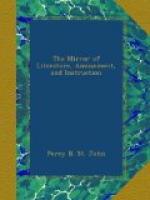THE MIRROR OF LITERATURE, AMUSEMENT, AND INSTRUCTION.
Vol. XIII, No. 358.] Saturday, February 28, 1829. [Price 2d.
* * * * *
[Illustration: York terrace, regent’s park.]
York terrace,
Regent’s park.
If the reader is anxious to illustrate any political position with the “signs of the times,” he has only to start from Waterloo-place, (thus commencing with a glorious reminiscence,) through Regent-street and Portland-place, and make the architectural tour of the Regent’s Park. Entering the park from the New Road by York Gate, one of the first objects for his admiration will be York Terrace, a splendid range of private residences, which has the appearance of an unique palace. This striking effect is produced by all the entrances being in the rear, where the vestibules are protected by large porches. All the doors and windows in the principal front represented in the engraving are uniform, and appear like a suite of princely apartments, somewhat in the style of a little Versailles. This idea is assisted by the gardens having no divisions.
The architecture of the building is Graeco-Italian. It consists of an entrance or ground story, with semicircular headed windows and rusticated piers. A continued pedestal above the arches of these windows runs through the composition, divided between the columns into balustrades, in front of the windows of the principal story, to which they form handsome balconies. The elegant windows of this and the principal chamber story are of the Ilissus Ionic, and are decorated with a colonnade, completed with a well-proportioned entablature from the same beautiful order. Mr. Elmes, in his critical observations on this terrace, thinks the attic story “too irregular to accompany so chaste a composition as the Ionic, to which it forms a crown;” he likewise objects to the cornice and blocking-course, as being “also too small in proportion for the majesty of the lower order.”
York Terrace is from the design of Mr. Nash, whose genius not unfrequently strays into such errors as our architectural critic has pointed out.
* * * * *
VALENTINE CUSTOMS.
(To the Editor of the Mirror.)
As some of the customs described by your correspondent W.H.H.[1] are left unaccounted for, I suppose any one is at liberty to sport a few conjectures on the subject. May not, for instance, the practice of burning the “holly boy” have its origin in some of those rustic incantations described by Theocritus as the means of recalling a truant lover, or of warming a cold one; and thus translated:—
[1] See No. 356 of the mirror, “Valentine’s Day.”




